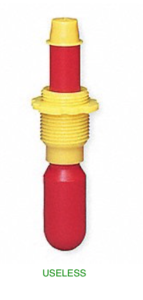The idea that started Gizmo Engineering began when I was working as a chemical process engineer in 1993 in the circuit board manufacturing industry. I was frustrated with trying to control the circuit board etching process. Despite sophisticated controllers to regulate the specific gravity on the conveyorized machines, the leading cause of process failure was that the drums of fresh etchant were constantly running empty!
I searched everywhere for a simple device that I could stick in a drum and have it beep. There was no such device available. The only device available seemed to be a pop-up gauge but it proved to be next-to-useless because it didn’t solve the problem: people were busy working instead of monitoring drums. Drums continued to be overfilled and the problem went unsolved.The closest thing I could find was a pop
So I lived with the frustrating problem for a long time, and after still more jobs were scrapped for the same reason, I decided to really try hard to solve this problem. Since the company I worked for “couldn’t afford” to purchase a solution, (despite losing thousands in scrapped jobs) the in-house maintenance department was to make something. What I ended up with months later was a 120V bare light bulb on the end of a stick. It lasted about 3 days before a drop of water landed on it, and it exploded, and that was the end of that.
I decided to have a plastics fabricator make something. Although expensive, crude, and prone to occasional failure, it did improve control of the nagging problem on one of the drums, until it broke months later.

The only other option seemed to be a “floats-on-a-stick” apparatus for that you have to wire up to your own alarm, and the exposed floats are prone to getting damaged during transfer to new drums. You’ve got to be kidding! Obviously this wasn’t the answer.
There had to be a better way!
I decided that if no-one else was going to make one then I would make my own Drum Alarm. It was much more effort than I ever could have imagined but, learning from the above experiences, the first one made in year 2000 worked very well. Over the years I made more and more units, improving and refining them along the way. Visiting sales reps saw these Drum Alarms and asked me if I would make some for other companies. Seeing the demand for them encouraged me to go into the business of making them, and later, other unavailable process control products.

